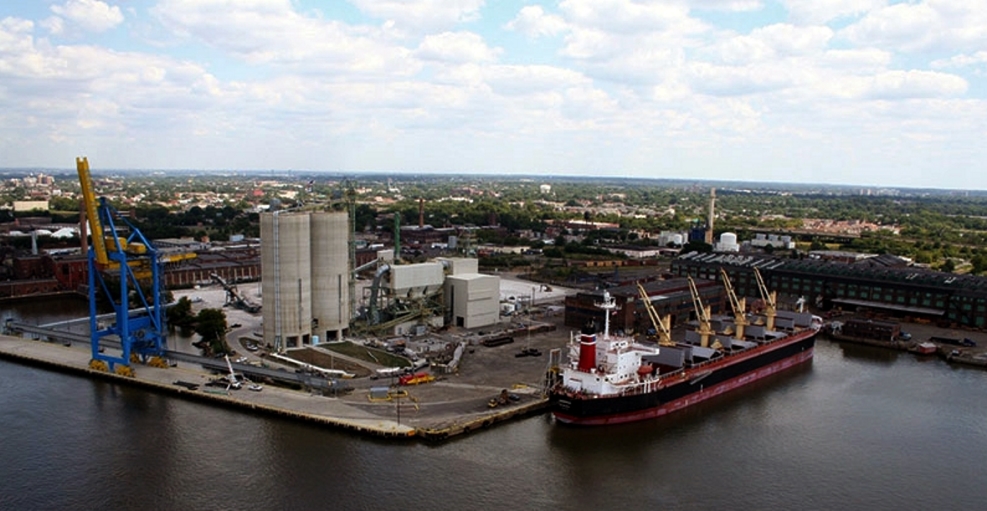Enjoying the first full year of operations at the initial phase of its Paulsboro Marine Terminal and weathering tariff-related impacts on steel volumes, the South Jersey Port Corp. is continuing to move breakbulk cargos at a record pace at its facilities along the New Jersey side of the Delaware River.
It’s easy to see why longtime SJPC executive Jay Jones is stoked, albeit while working extra-long hours and wearing several figurative hats.

The overall gain was eked out despite negative impacts of import tariffs put in place by the Trump administration in March 2018.
“During the last year, since our terminals here in Camden and Paulsboro are very steel-oriented facilities, the steel and aluminum tariffs did take a chunk out of us, so our increases would have been more,” Jones told AJOT.
Now in his 29th year with the SJPC, Jones last April, upon departure of 32-year SJPC veteran Kevin Castagnola, added acting executive director responsibilities to his roles as the quasigovernmental entity’s deputy executive director, facility security officer, public information officer and board secretary.
Paulsboro operations, which got under way in March 2017 with a single 850-foot-long berth, are in the process of being amplified. The Paulsboro facility, operated by Holt Logistics, has been ballyhooed as the first major new port terminal to be built on the Delaware River in more than half a century. Its primary user is NLMK USA, a unit of Russia’s largest steelmaker, which imports steel slabs from Russia and sends them on unit trains to mills in far Western Pennsylvania and Northwest Indiana.
The SJPC, in conjunction with the Gloucester County Improvement Authority, is moving forward with second-phase Paulsboro Marine Terminal construction at the former BP tank farm site across the Delaware River from Philadelphia International Airport, with a contract having been issued last summer to build out two more ship wharves and a barge berth.
“Those berths will come online in a staggered process as they are completed,” Jones said. “In about three years, we’ll complete the phase two construction. It will grow exponentially as they come online over the next three years.
“Once we get another berth online, it opens up the opportunity for new lines and new customers for the terminal,” he added.
Undertakings at the 200-acre Paulsboro property also include improving an additional 80 acres of terminal space, augmenting the 50 acres unveiled in the first phase, as well as utilities enhancements.

Some $45 million in bond-backed projects at Camden terminals include maintenance dredging, now under way by Weeks Marine, and pier and bridge improvements.
A rail access improvement project at the Broadway Marine Terminal is advancing thanks to a New Jersey Department of Transportation freight rail systems grant, while the SJPC is engaged with Conrail in building of a wye track to create greater efficiencies and, at the same time, benefit motorists going in and out of the town of Paulsboro.
“These enhancements increase and improve the state’s intermodal capabilities and generate economic development and jobs, and it’s a good place to invest,” Jones said. “Our operations every day involve all sorts of public-private partnerships and coordination with multiple companies to bring the ships up the river and work the ships.”
In addition to the handling of various steel cargos, including slabs, coils and structural steel, SJPC facilities bustle with such varied activity as imports of cocoa beans (destined for local chocolate factories), wood products and blast furnace slag, while exports are highlighted by cement and recycled metal.
At the SJPC’s 28-acre Salem Marine Terminal – at a location that incredibly enough dates back to 1682 as a port of entry – U.S. Concrete last year handled 417,000 tons of sand and gravel, up 35 percent over 2017 volume. The bulk cargo originates in a South Jersey quarry and heads out by barge to New York state.
“Our specialty is handling breakbulk cargos and some dry bulk,” Jones said, noting that SJPC facilities seldom see movement of containerized cargos.
Also, SJPC leadership is working with the national Foreign-Trade Zones Board to reorganize the port’s FTZ No. 142 under the alternative site framework, aimed at providing zone users with better and quicker access to FTZ benefits, such as deferral, reduction or even elimination of U.S. Customs duties.




